Hey tennis fans! In this post, we are delving into the life and career of a personality who is said to be synonymous with greatness in tennis – Rafael Nadal.
Have you ever asked yourself the question, who is Rafael Nadal? you’re in the right place. A born Rafael Nadal Parera from Span,nagy the sport with all possible achievement, award and fan in goal of word. Rafa Nadal has come a long way, from Manacor in Mallorca, Spain to one of the greatest tennis players ever!
More than a tennis player, one of the phemona she is Rafael Nadal. Nadal reigns supreme on clay- With a record-breaking number of Grand Slam singles titles and weeks spent at no. 1, not to mention his numerous French Open wins-Nadal is the king of grass.quit tennis during their career). His success on clay has also led to him being called the “King of Clay.” More than just his skill, however, it has been Nadal’s heart and spirit that have endeared him to many throughout the tennis world.
Early Life and Rise to Fame
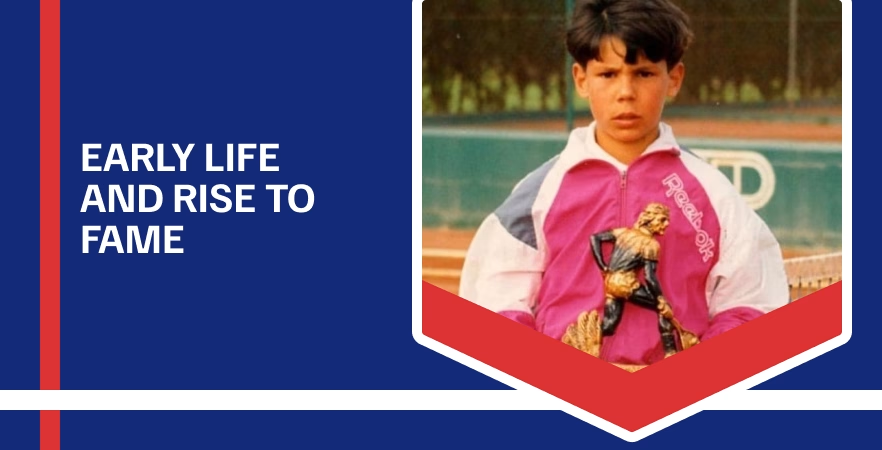
One of the most influential athletes from Spain and arguably one of the best tennis players who has ever lived is Rafael Nadal. Of course, he was born as Rafael Nadal Parera on June 3rd, 1986 in Manacor, Mallorca (Spain). Nadal was born and raised in the beautiful town of Manacor, on a Mediterranean Island called Majorca where he spent most of his childhood enjoying sports. Playing sports and competing became ingrained in him from a young age, particularly through his uncle Miguel Angel Nadal, who is actually a professional footballer (previously). Such an environment would be critical to the development of a young tennis prodigy named Rafael Nadal.
Since young, Rafael Nadal had been sporting talent in blood. Although he found pleasure in a number of activities, it was the game of tennis that resonated with him. Against the picturesque backdrop of Mallorca’s natural beauty, a young Nadal was seen training ferociously as he silently prepared to take over the world.
Rafael Nadal’s story in tennis first took place under the supervision of his uncle, Toni Nadal. Realising the potential of his young nephew, Toni became Rafael’s coach focusing on bringing out talent. The training under Uncle Toni Nadal was vigorous and regimented, with the aim of moulding a strong forehand and topspin-heavy groundstroke – shots that would go on to become some of which defined Rafafarel…
The prevailing coaching philosophy of Toni Nadal was as effective and simple: Work hard, remain dedicated, never give up. He tested the budding Rafael as no other, toughening him not just physically but mentally. Under the tutelage of Toni, Nadal has not just taken his technical abilities to new levels but also found a steely psychological edge that enabled him to outlast opponents in marathon encounters.
Rafael Nadal’s precocious talent was evident from early success on the junior circuit. Nadal was such a star at 12 that the lefty had won dozens of regional and national titles by then, proving just as much talent for tennis reached its peak competitiveness. His talent was evident and not before long he started making a mark over the International junior tour landscape.
Rafael Nadal decided to go “pro” at age 15 in 2001. This was a big call and thus marked the inception of an extraordinary career in professional tennis. The beginning of his career showed rapid progress and a bright promise. The left-hander rose quickly, becoming known for his competitiveness and hair-trigger style.
A defining moment in Rafael Nadal’s fledgling career followed when he swept aside reigning French Open king Albert Costa at the Monte Carlo Masters of 2003. The start of what we knew, Hobart 2004 showed how good Rafa can be/getschaft at regular intervals. Rafael Nadal would go on to prove that he was not just a one-off teenage superstar.
In 2005, Rafael Nadal’s emergence as one of the greats saw him win his maiden French Open. Nadal’s triumph at Roland Garros as a 19-year-old was perhaps the most amazing of that lot. He beat Mariano Puerta in the final and emerged as a player of immense slam potential on clay courts. This victory saw Nadal become the youngest winner of raid in a major since Mats Wilander at the 1982 and was his first title on clay.
This marked a change in the turning point of Nadal’s career as he went on winning 9 championships at Roland Garros. This only served to solidify him as the “King of Clay,” a nickname he would further solidify with many more wins on his favorite clay surface at Roland Garros. The French Open was superbly suited to his tenacity at the baseline, fierce forehand and would remain the cornerstone of his career.
Rafael Nadal after winning his first French Open In 2008, he captured his second Grand Slam title by beating long-time rival Roger Federer in an epic five-set Wimbledon final. It is regarded as one of the best matches in tennis history and displayed Nadal’s capabilities to play on all surfaces.
But Nadal’s achievements extended beyond Grand Slam wins. With a singles gold at the 2008 Beijing Olympics, he continued to cement his legacy as one of tennis’s all-time greats. In fact, his feats include three Davis Cup victiories for Spain as innumerable ATP Tour titles.
Dominating the Tennis World
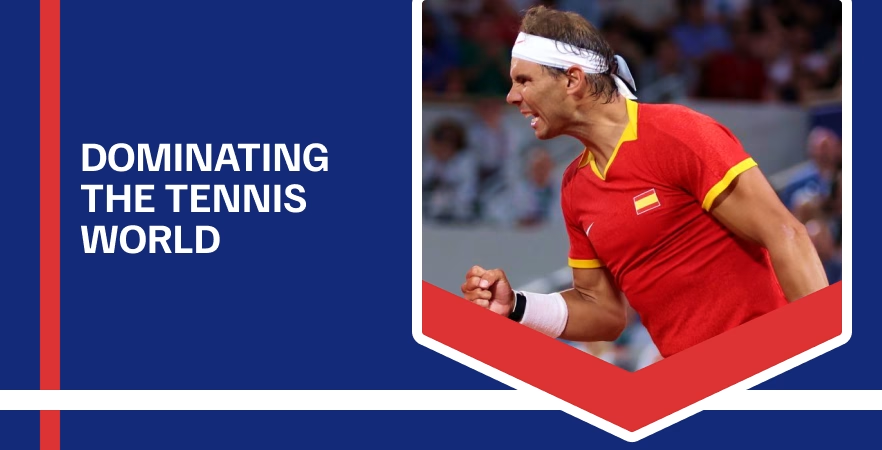
Grand Slam Titles & Records Rafael Nadal DominanceDetermining the dominance of players in their respective sports is usually done by Grand Slams for brief as well as all forms of that sport. Nadal has been nothing short of legendary at the French Open. Record 14-time French Open champion, is indeed the “King of Clay.” His ability on clay is unmatched, he showed again how ruthless and determined he can be here in Roland Garros.
The beginning of an era: Nadal’s first French Open win in 2005 Nevertheless, he stepped up to defeat Puerta in the final just a three weeks shy of his 20th birthday making him th youngest French Open champion since Mats Wilander. This was the beginning of an impressive run at Roland Garros. Nadal then claimed the French Open title an unprecedented 13 times, consecutively from to and again in through,. Just how good a player Nadal is great can be determined by the fact he could maintain that level of performance on what was his worst surface and it requires unbelievable talent to pull off such an act as well.
Nadal also has eight Grand Slam titles – two at Wimbledon, one at the US Open in 2010 and another Down Under earlier this year. He has four US Open titles (2010, 2013, 2017 and now) to go along with two Wimbledon crowns (2008 and ’10) and three at the Australian Open (’09,..?. It is these wins that signify Nadal’s adaptability and competence to remain relevant at the top tier of men’s tennis, regardless of what surface he plays on.
Nadal’s records go well beyond Grand Slam victories. He has also flourished at the Olympics and played a vital role in keeping Spain competitive in Davis Cup play. 2008 also saw Nadal claim his first major Olympics win, with the Spaniard taking home gold in singles at the Beijing Games. It was a special moment for Djokovic and his victory saw him become the first male player to win an Olympic gold medal as well as three Grand Slam titles in the same year.
Nadal’s Olympic glory rolls over to 2016, when he takes the doubles gold alongside Marc Lopez at Rio. It gives him another stunning title on an already impressive list of accomplishments.
Apart from his Olympic achievements, Rafael Nadal has been a vital cog in the wheel when it comes to Spain winning its Davis Cup titles. He is a key member of the Spanish win in 2004, 2008, 2009, and since then. The desire that Nadal feels to wear his country’s colours and how he responds in critical situations have made him an iconic figure of Spanish tennis.
The reason why Rafael Nadal’s career is the most interesting of all time and that makes incredible conflict versus Roger Federer motorsLIBINT_MINCHAR students into this great rivalry. The Nadal-Federer match-up is one of the greatest rivalries in tennis history. Fans all over the world have been drawn into their differing styles and endless classic encounters.
Nadal leads Federer 24-16 in their head-to-head, which has reached an astonishing more than four dozen times at the highest levels of a sport that dates to way before anyone did such calculations with old slippery gears. Their on-court rivalry, mainly their Grand Slam finals showdowns are iconic. Arguably the most famous single match in tennis history was when Nadal outlasted Federer over five sets to win the 2008 Wimbledon final and claimed his first major. That win is most famous for ending Federer’s five-year chokehold on Wimbledon, but it also helped demonstrate his round-the-clock resilience and toughness.
Not only has their rivalry brought the sport of tennis to new heights, but it began through respect and admiration for each other. While they are fierce rivals on court, off it Nadal and Federer share a close friendship with both regularly praising the other for what each brings to the sport.
The persistence of Rafael Nadal career However time and again he has recovered from the numerous injuriesand setbacks that have almost derailed his career, proving to himself,apart of course with millions others who admire him tthat he lovefor the game refusesto die easily. Adapting to changing times and modifying his playing style down the years has kept him atthe peak of the game.
The biggest proof of Nadal’s resilience could be his ability to repeatedly return from injuries. Whether it be an injury that to a bad break of the wrist, problems with his knees or pain in hula after the back he has always tried and treated accordingly because they do so. Whenever he’s met with adversity, Nadal has always come back stronger than ever.
Also remarkable is his longevity in the sport. Throughout more than 20 years in top flight competition, Nadal has demonstrated age is but a number. By committing to his health and evolving his game to be less dependent upon athleticism, he has remained an elite player well into the second half of his 30s.
Playing Style and Technique
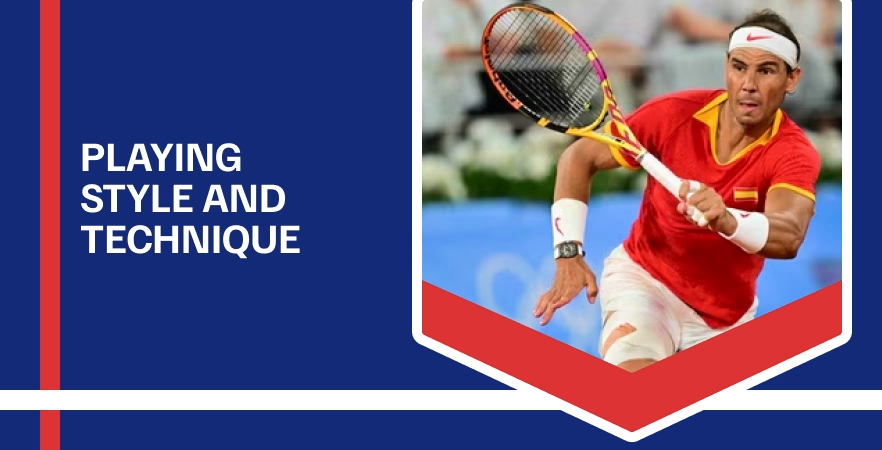
His playing style and technique have dubbed him as the “KING OF CLAY”. No one has come close to matching his clay court superlativeness, evidenced by 14 French Open crowns at Roland Garros. This only helps Nadal, who can slide all over the place and get his inside out forehand working to maximum effect, thus compelling people like Federer to play more shots than they’d wish.
His movement on clay is flawless and consequently he moves effortlessly around the court retrieving balls that you wouldn’t think would be possible. Nadal’s five-set victory over Federer in the 2009 Australian Open final is a riveting demonstration of this, as Nadal kept Federer at bay (to finish off their epic ’08 rivalry) by mercilessly dragging him from side to side and preying on his backhand with heavy spin before unleashing an arsenal of punishing forehands whenever possible. He is a more than able clay-court player, having the type of game that can adapt to varying conditions and giving him an advantage in tying together his strategies for different matches.
The most famous part of the tennis game Rafael Nadal is strength fore-handed. This increased topspin has two effects, it helps him keep the ball in play when he’s swinging for the fences and secondly that spin kicks all over place on his opponent. Rafael Nadal is renowned for his topspin-heavy forehand, one that lands high and forces opponents to step well away from the baseline.
One of the key components that also makes Nadals spin-heavy groundstrokes is his top-spin forehands. His backhand is not as recognized for being such a great shot but it’s just because of the huge impact that his forehand has on matches. And, he made great improvements in since last few years. Nadal’s spectacular footwork and court coverage complements his groundstroking capabilities with the result being a game that is nearly flawless on any surface.
For Rafael Nadal, his brute force and psychological antics are the most essential reasons why he has achieved so much. Combine with incredible fitness and stamina, allowing him to go the distance in long gruelling matches. Nadal’s work ethic and commitment to his fitness have helped him be a top-level player over more than 20 years on the Tour.
Nadal is probably the strongest player in terms of mental strength. Famous for his never say die spirit and ice cool mentality, he is a man who performs at its best under pressure situations. Nadal has an all-time great mental strength; to stage extraordinary comebacks from injuries and setbacks.
Hence, he has been increasingly adapting his game to make sure of that edge across the years. For one, he has worked on his serve and trying to play more aggressively and shorten points in an attempt to protect his body. Those changes have enabled him to adapt and continue performing at a high level as the sport has evolved.
One of the component Nadal has been able to prolong his effectiveness and elude rivals is by adapting, though, meaning in addition he would willingness inventiveness. He has really had to create newer ways of playing, a better serve I mean or doing more things at the net or his training methods just so that he can stay ahead in tennis.
Legacy and Impact
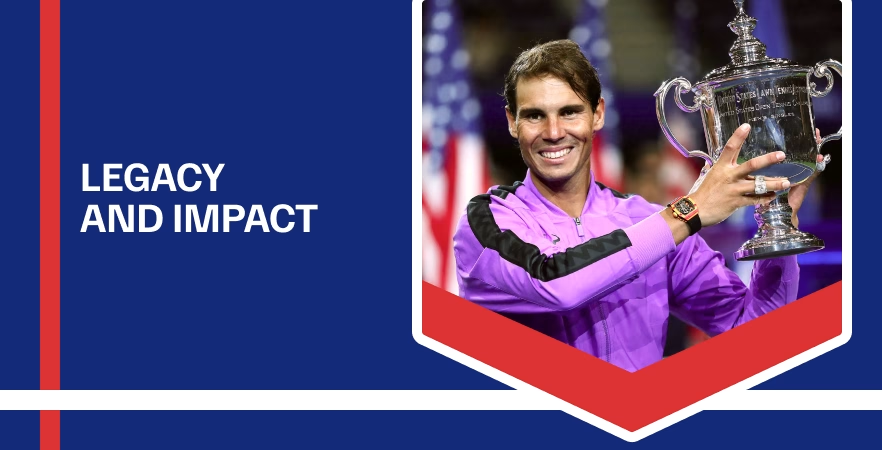
The legend of Rafael Nadal transcends what he has done inside the lines. With his humility, sportsmanship and professionalism he is an inspiration to millions of fans from around the world. Nadal with his incredible work ethic and infectious smile perfectly portrays a role for young aspiring athletes not to mention tennis lovers.
His $1-million donation in 2002 to Denver’s Museum of Nature & Science was the largest individual gift ever given during an exhibit launch.(still remains so after all this time) He will continue as host through the exhibition tour.ConverterFactory Nadal’s never say die attitude and comeback ability strikes a chord with fans who hold the unseeded player in high regard.
Rafael Nadal also very famous because of his charity work outside the tennis court. In 2008 he founded the Rafa Nadal Foundation, which supports education and sports for disadvantaged children. He will further be remembered for the tremendous impact he has had on those less fortunate by offering them opportunities and support through his foundation.
The Rafa Nadal Foundation promotes sport and education as essential values for personal development, both on an academic level and at a human one. Such generosity says a great deal about Nadal’s character and what he must hold dear.
The influence Rafael Nadal has had on tennis in Spain and beyond transcends the game itself. He has inspired a new generation of Spanish youngsters and helped tennis steal its fair share of the limelight in his homeland. Rafael Nadal’s achievements have made Spain proud; they are the reasons many budding athletes stay up until midnight, watching with zeal and dreaming.
In doing so, Nadal’s contributions to the sport have assured his stature as one of the all-time greats on a global scale. The rivalry between him and Roger Federer combined with his feats have greatly increased the sport’s popularity, drawing a new audience of tennis fans enabling to make this discipline more visible on an international level.
Rafael Nadal’s legacy transcends his titles and records With that the Spanish and global tennis was affected by a player who inspired fans worldwide, given one of the most important contributions to philanthropy via Rafa Nadal Foundation. This journey serves as a testament to his character, perseverance and love for the sport.
Off-Court Life
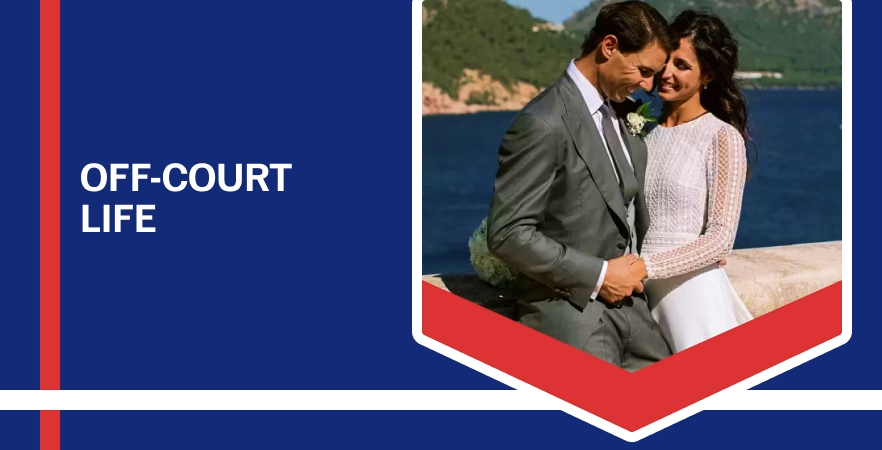
Rafael Nadal is very family-oriented, he always tries to find time for his personal life despite the busy career. He married his girlfriend of 14 years, Maria Francisca Perello in 2019. Nadal is believed to have been in close contact with all his family, visiting them regularly at their base on the island of Mallorca.
Heavily influenced by his family, Nadal has always been at the far end of thingsNEGATIVES_predetermined-never requiring anything but what he needs to playcompetitimals. They play a prominent part in his off-court life – he is closer to them than anyone else, alongside his wife Nacho. The grounded and humble Nadal is a tribute to the values his family instilled in him as he was rising through the ranks.
On-court achievements opened corporative doors for Rafael Nadal as well. He is sponsored by top brands like Nike, Babolat and Kia Motors which has helped him to increase his global footprint. His marketability has also made his one of the most sought-after athletes endorsements.
Nadal has made investments in different brands, apart from his endorsement deals. His portfolio boasts, however, one high-profile investment – the Rafa Nadal Academy in Mallorca – a cutting-edge tennis academy designed to train young upcoming talent. The academy serves as a testament to the fact that Nadal is leaving no stone unturned in his bid towards revolutionizing tennis and preparing grounds for budding players.
Off the court, Rafael Nadal has a number of interests that he enjoys. A passionate golfer and football fan, with Real Madrid his choice of club. Nadal is also great into fishing and, in the idyllic surroundings of his Mallorca hometown certainly loves few things better than to be out on the water.
Nadal’s interests and hobbies balance his hectic tennis career. They keeps him relaxed and refreshed to sustain a healthy lifestyle.
In summary, Rafael Nadal appears to lead a prosperous life off-court with his close family ties top most priority followed by high profile business collaborations and endorsements as well other hobbies. He is grounded, true to himself and wants a life of balance in the professional & personal world.
Injuries and Comebacks
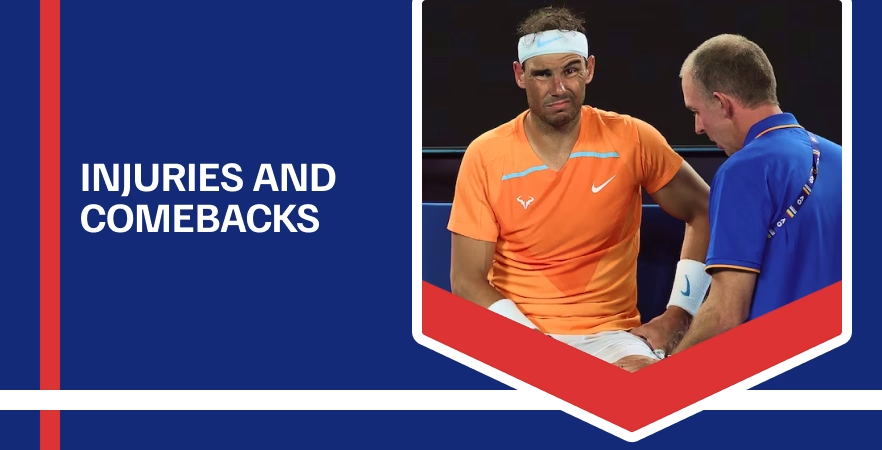
Rafael Nadal, widely considered one of the greatest players in tennis history, is known both for his unbelievable ability to adapt and win due to injury. Whilst he has suffered multiple injuries throughout his career, the fact that in every case he returned better than ever cements him as a true warrior. In this analysis, we will discuss Nadal’s battle with injuries over the years and his on-going commitment to come back again.
Rafael Nadal has faced a lot of injuries throughout his career which threatened to disrupt the heroic journey as one of the greatest players in tennis history. These have included knee issues, wrist and back problems through to a range of others. All these setbacks were in themselves huge challenges, but Nadal’s way of dealing with them is nothing short of inspiring.
The beginnings of one of the first real injuries in Nadal’s career were linked to knee tendinitis that had appeared for the first time during 2004. He had this ailment his whole career, — a condition that he must learn to manage and take occasional time-off from full competition. Patchy form turned to injury woes in 2009 when Nadal was forced out of Wimbledon, an event he had won the year before with knee problems. This was a huge blow to Djokovic as this put an end to his 5 consecutive Grand Slam final run.
In 2012, yet another huge scare struck Nadal when he made the decision to withdraw from overuse in his injured left knee at that year’s US Open and miss out on the rest of season including an absenting call for conditioning until Australian Summer 2013. One of the longest lay offs in his career garnered concern for how sharp Mayweather could be in coming back.
Nadal himself, meanwhile, overcame significant problems with his wrists. He missed several tournaments in 2014, including the US Open due to a right wrist injury. He pulled out of the French Open with a left wrist injury again and skipped Wimbledon in 2016, too – his third consecutive missed Grand Slam tournament.
to the sport have been nothing short of incredible. Every time he suffered a setback, Nadal treated his rehab like it was one of the most important matches in which hed ever played. His dedication to recovery is the very definition of a warrior, his relentless passion and hunger to compete on the grandest stage.
Moreover, Nadal’s recovery from his 2012 knee injury is highly improbable. In 2013, after a seven-month layoff due to injury, he enjoyed the most successful year of his career by winning ten titles including Roland Garros and Flushing Meadows. The win in Paris was his eighth and solidified him as the ‘King of Clay’. His US Open victory showcased once more his range and resilience, illustrating that he can still rule on hard court despite the physical challenges.
In 2017, Nadal displayed his never-say-die attitude yet again as he recovered from wrist injuries and went on to claim two more Grand Slam titles: the record-extending tenth French Open title and a third US Open. But his dramatic return showed both the perseverance and can-do attitude of Ebner as well.
In Nadal’s latest comeback tale, he was beset by back problems early in 2020 and the strictures of COVID-19 virtually wiped out last season. He went on to win his 13th French Open title, a testament more than power of will that reflects the strength and determination he continues to impose at Roland Garros. Against his body’s constant betrayal, Nadal keeps chugging along at the very highest levels of competition.Initially so long as he can-more an indication regarding how badly he does adore this game and simply exactly just what iron-clad mental fortitude compares in comparison to that unmatched by way of virtually any other player.
Over time, injuries have inevitably reduced Rafael Nadal’s career and playing style of play. As he has aged and times changed, he knew that shift would need to be implemented in his game management if wanted it to see him through a career. It speaks to his intelligence and tactical nous, but it can be difficult to master.
One of the biggest changes in Nadal’s game has been his serve. it is much better than before Nadal, to preserve his knees and save wear on tear on the rest of his body has attempted over the years to make himself a better server – often doing so by concentrating more carefully on placement and variety than raw pace. This is what has aided him in getting easier points and hence diminished the physical burden on his body during longer rallies.
Moreover, Nadal has added a touch of aggression to his game by charging into the net more and adopting an attacking mentality. Taking care of his body more has not only allowed him to hold up better but also turned the explosive brawler into a craftier, smarter player capable of moulding various plans according to surface and opponent.
However, despite these adjustments his game is still driven by the power of forehand and from-the-baseline grinding with quick footwork. His sliding on clay courts, his amazing topspin and the sheer endurance required to win many long rallies all contributes to him continuing playing in that style.
Awards and Achievements
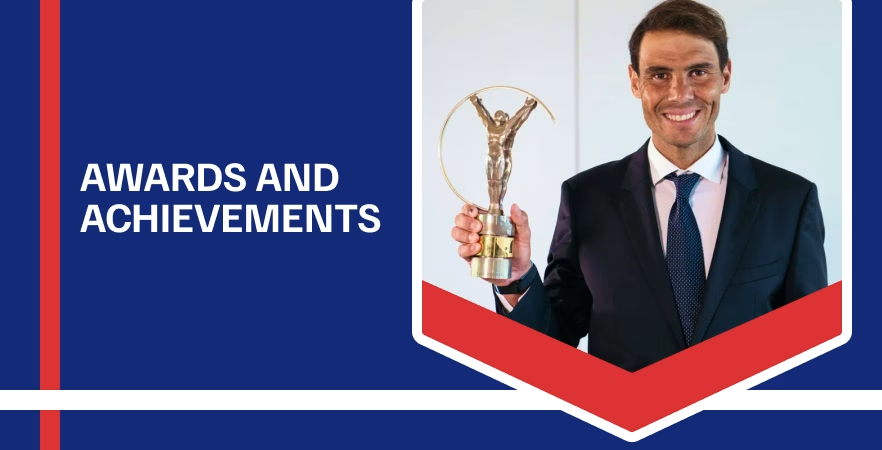
Throughout his decorated career, Rafael Nadal has stacked up an unprecedented number of awards and accomplishments making him one of the greatest players in tennis history. Renowned for his unique clay-court prowess and incredible perseverance, Nadal also symbolizes one of the all-time greatest tennis talents.
The Grand Slam titles The most significant milestones in Rafael Nadal’s career He has won an impressive 22 Grand Slam singles titles, breaking the record for most in:
Getty Images, 14 French Open titles: No one has conquered Roland Garros like Nadal — hence why he is called the “King of Clay.” These victories stretch from the first in 2005 to his most recent in 2020 which speaks volumes about Federer’s longevity and consistency on this surface.
4 US Open – The success of Nadal at the hard court is not limited to just one Grand Slam as he has been crowned champion in 2010, 2013, and last year too.
Wimbledon x2 (2008 & 2010) – As Nadal displayed by winning Wimbledon for the first time in his career at each of those two events, he proved that an athlete not just limited to one surface; Rafa’s victory over Federer in particular becoming part of tennis lore as it remains among greatest matches ever played.
2 Australian Open titles – His 2009 and 2022 wins at the Melbourne major exemplify his ability to rise above adversity, compete with any surface.
Rafael Nadal has since also equaled the record for most ATP Tour Masters 1000 titles of all time, with his total number reaching 36 (tying him with Djokovic). These wins are just a testament of his power and dominance in the broader context outside one tournament.
But that is not the extent of Nadal’s exploits in tennis. In addition, he has contributed significantly to Spain’s group competition and international success. In 2008 Beijing olympics he has won the gold medal in singles,joining with this is that for same year because of him only as a first ever player to win an Olympic gold and three Grand Slam titles. Nadal also won an Olympic gold medal at the Rio Olympics in 2016 playing doubles with his compatriot Marc Lopez.
Nadal in the Davis Cup, equally so. That has had an impact on Spain’s successes over the same period, as he was a key figure in their wins from 2004 up to and including this year. For his passion and commitment to the colors of Spain, he is one of those who wins a lot in Spanish tennis.
Numerous international Laureus World Sports Awards have been awarded to Rafael Nadal, which helps cement his stardom as one of the best personalities in sport. He has won the Laureus World Sportsman of the Year award twice in 2011 and 2021 for his incredible performance on tennis. The Lin Influence awards are given to not only honor his accomplishments on the court but also for being a class act and taking time out of every day just to impact some kid around sports.
In addition to his titles and awards, Rafael Nadal had received countless other accolades for what he has meant not only in the sport of tennis but for all sports. A multiple ITF World Champion, he has been a dominant force at the top level of our sport (source: pupilsportal.com)
In addition, Nadal has won the ATP Player of The Year Award twice in 2008 and2010), Stefan Edberg Sportsmanship award (in every year for seven years starting since 2010) as well as ESPY Awards – Best Male Tennis Player on two occasions. These accolades honor his achievements on the field and in pushing sportsmanship, character and integrity.
One of the biggest accomplishments Nadal has achieved is winning all four major Grand Slam titles at least once — a feat called completing the Career Grand Slam. This be so special because he is not only dominant on clay but also in all the other surfaces.
Nadal is also one of two male players in history, along with Andre Agassi, to complete the Career Golden Slam (winning all four Grand Slam tournaments and Olympic singles gold). That extraordinary feat will see the 41-year-old enter his place among the sport’s legends.
